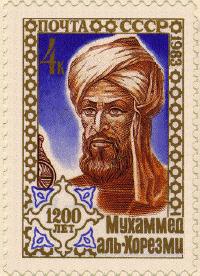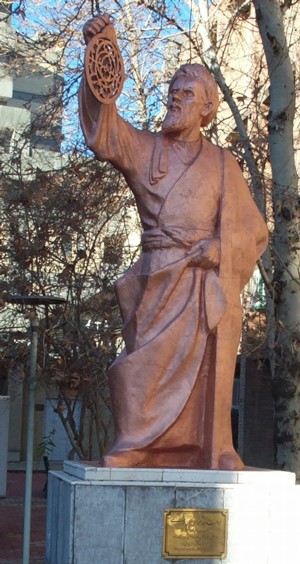(Muhammad ibn Musa al-Khwarizmi)
Arab mathematician, b. c. 780 (Khwarizm), d. c. 850.
 Muhammad ibn Musa was born in Khwarizm, today's Khiva south of the Aral Sea and is known in history as al-Khwarizmi. A mathematician and astronomer, he lived and worked in Baghdad during the first golden age of Arabic science under the caliphs al-Ma'mun and al-Mu'tasim.
Muhammad ibn Musa was born in Khwarizm, today's Khiva south of the Aral Sea and is known in history as al-Khwarizmi. A mathematician and astronomer, he lived and worked in Baghdad during the first golden age of Arabic science under the caliphs al-Ma'mun and al-Mu'tasim.
Several works of Al-Khwarizmi are known. He wrote the Mafatih al-'Ulum ("Key to the Sciences"), the first Arabic encyclopaedia of knowledge that was organized on scientific principles. Its contents was classified into indigenous knowledge (jurisprudence, scholastic philosophy, grammar, secretarial duties, prosody and poetic art, history) and foreign knowledge (philosophy, logic, medicine, arithmetic, geometry, astronomy, music, mechanics, alchemy).
Al-Khwarizmi's fame as a scientist derives from his achievements in mathematics. His work on arithmetic was translated into Latin in the 12th century, and although the original is lost, the Latin translation Algoritmi de numero Indorum ("The al-Khwarizmi on the Indian numbers") still exists. Its title gave rise to the mathematical term "arithmetic."
Al-Khwarizmis' other work, Kitab al-jabr wa l-muqabala ("The Book of Integration and Equation," literally "reduction and comparison"), was the synthesis of Indian algebra and Greek geometry and had the most profound effect on the development of science. Latin translations, summaries and commentaries were written from the 12th century onward. The mathematical term "algebra" was derived from its title.
Al-Khwarizmi also published astronomical and trigonometric tables based mainly on an Arabic translation of the Indian astronomical work Brahma-siddhanta that was written about 100 years before. During the 10th century Maslama al-Majrti revised the tables and added his own table of the tangent to al-Khwarizmi's tabulation of the sine function. In that version the tables were translated into Latin in 1126 by Adelard of Bath.
 The Kitab al-jabr wa l-muqabala gives solutions to equations through the process of al-jabr and al-muqabala: An equation is first transformed into one to which the solution is known. Six such equations are given and discussed in the work (Benoît and Micheau, 1995):
The Kitab al-jabr wa l-muqabala gives solutions to equations through the process of al-jabr and al-muqabala: An equation is first transformed into one to which the solution is known. Six such equations are given and discussed in the work (Benoît and Micheau, 1995):
ax2 = bx
ax2 = c
bx = c
ax2 + bx = c
ax2 + c = bx
bx + c = ax
where all numbers are positive. The solutions to these equations are given as algorithms, and their proofs are given through geometrical argument. As an example, al-Khwarizmi solves an equation of the fourth canonical type as follows:
"Let the square and ten roots be equal to 39. [In other words, the square of the unknown and ten times the unknown equals 39, or x2 + 10x = 39.] The rule is that you divide the roots into two halves (here we get 5), which you multiply by itself (we have 25), to which you add 39 (and we get 64). You take the root (which is 8), and you reduce it by half the number of roots (which is 5, giving 3), which is the root of the square for which you are looking (the square being 9)." In modern notation this rule is expressed as

Statue of al-Khwarizmi in front of the Faculty of Mathematics of Amirkabir University of Technology in Tehran, Iran.
Benoît, P. and F. Micheau (1995) The Arab Intermediary. In: M. Serres (editor): A History of Scientific Thought, Elements of a History of Science. Blackwell, Oxford, 191 - 221. (Translation of Éléments d'Histoire des Sciences, Bordas, Paris, 1989)